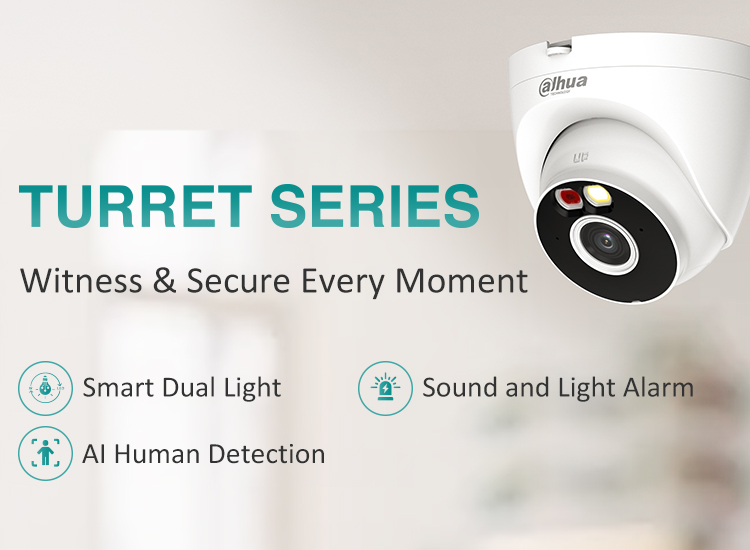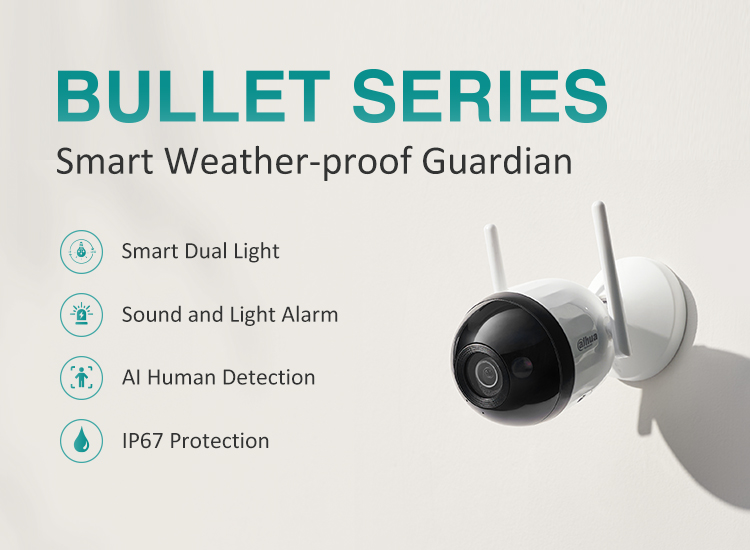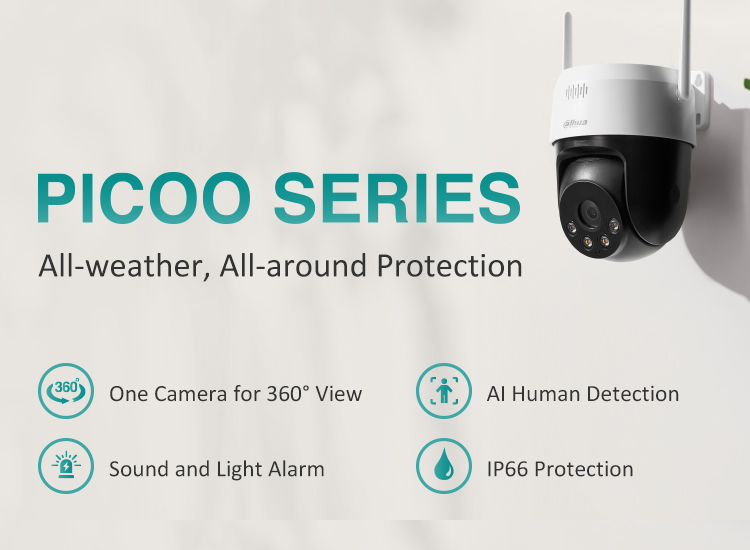ARTICLES
- HOME
- -
- ARTICLES
Dahua Wireless series for Small & Medium Sized Scenarios
.jpg)
Hangzhou, China will be hosting an event on November 22, 2023. Dahua Technology, known for its top-of-the-line video-centric AIoT solutions and services, introduces the Dahua Wireless Series. This innovative product line consists of versatile, portable, and wireless cameras, specifically designed for small to medium-sized application environments. The Turret, Picoo, Bullet, and Hero series are in the range. They are all created with the purpose of offering simple installation and inconspicuous surveillance for your property.
With the continuous advancement of technology and changes in consumer demand, the security camera market is facing diversified demands. After a series of innovations and research, Dahua Wireless series cameras not only achieve easy installation and operation but also excellent performance and cost-effectiveness. By adopting the latest wireless technology, users can easily install and use the camera without tedious cabling, achieving true wireless. In addition, the camera is equipped with auto-tracking, human detection, privacy mode, two-way talk, smart dual light, proactive deterrence, and other functions. These cameras are widely used in small and medium-sized scenarios such as small-sized.
Indoor Cameras:
Smart Shop Assistant
- Hero is an acronym for the House & Enterprise Remote Observe

- The perfect Integration of Speed and Anti-Interference(Wi-Fi6)
- Proactive bidirectional call anytime, anywhere.
- Focuses on what matters, reduces false alarms.
- Guards the places that matter to you regularly.
- 360° monitoring without blind spots.
- Protect your privacy.
- Record a complete Event by Tracking the Target's path.
- Communication Anytime, Anywhere.
- Detects Abnormal Sounds and Sends Alarm in Time.
- Diversified Storage.
- Make Cyberspace a Safer Place.
Smart & Flexible Guardian
- Advanced H.265+ Compression Technology.

- Focuses on what matters, reduces false alarms.
- Protects your privacy.
- Communication anytime, anywhere.
- Convenient and flexible installation
- Record a complete Event by Tracking the Target's path.
- Communication Anytime, Anywhere.
- Detects Abnormal Sounds and Sends Alarm in Time.
- Diversified Storage.
- Make Cyberspace a Safer Place.
Witness & Secure Every Moment
- Convenient and Flexible Installation.

- Captures Full-colour Details (-LED model).
- Provides Traceable Audio Details (-LED model).
- Multiple Night Vision Modes to Meet All Needs (-PV model).
- Provides Instant Alarms to Deter Intruders (-PV model).
- Focuses on Target, Saves Labor Costs.
- High-Resolution Video
- Day/Night Functionality
- Wide Dynamic Range (WDR)
- Smart Analytics
- Remote Viewing and Control
- High-Resolution Imaging

- Day/Night Functionality
- Wide Dynamic Range (WDR)
- Pan, Tilt, and Zoom (PTZ)
- Vandal Resistance
- Audio Capabilities
- Weather Resistance
- H.265+ Compression Smart
- Analytics
- PoE (Power over Ethernet)
- Privacy Masking
Outdoor Cameras:
Smart Weather-proof Guardian
- Captures Full-colour Details (-LED model)

- Provides Traceable Audio Details (-LED model)
- Multiple Night Vision Modes to Meet All Needs (-PV model)
- Provides Instant Alarms to Deter Intruders (-PV model)
- Focuses on Target, Saves Labor Costs
- Reliable and Durable
- High-Resolution Video
- Night Vision
- Weatherproof Design
- Motion Detection & Alerts
- Remote Access & Control
All-weather, All-around Protection
- Picoo is an acronym for PT in Camera for Outdoor Observation

- 360° monitoring without blind spots.
- Focuses on what matters, reduces false alarms.
- Guards the places you care about regularly. (Picoo B1)
- Provides instant alarms to deter intruders.
- Communication anytime, anywhere.
- Weatherproof Design.
- Day/Night Functionality
- Affordable Pricing
- Smart IR Technology
- H.265 Compression
- IR Night Vision
- 2.4 or 5 GHz WiFi Options, IEEE802.11a/b/g/n/ac

- Smart H.265+ and Smart H.264+ Dual Codecs
- Maximum Resolution of 4MP at 30 fps
- Active Alarm with Integrated 110 dB Siren and Floodlight
- Built-in Microphone and Speaker
- IP65 Ingress Protection.
- Integrated Floodlight.
- AI-Powered Analytics.
- Line Crossing Detection
- Face Detection
Advantages of Wireless Cameras:
Wireless cameras, also known as WiFi cameras or IP cameras, offer several advantages over traditional wired cameras:
- Ease of Installation: One of the most significant advantages is the ease of installation. Wireless cameras do not require complex wiring, which reduces installation time and effort. This makes them ideal for both temporary setups and locations where running cables is impractical or costly.
- Flexibility and Mobility: Wireless cameras can be placed virtually anywhere within the range of the WiFi network they are connected to. This flexibility allows you to easily reposition the cameras as needed without dealing with physical cables.
- Remote Access: Most wireless cameras can be accessed remotely over the internet. This means you can view live footage, receive alerts, and manage settings from anywhere using a smartphone, tablet, or computer. This remote access capability is especially useful for monitoring homes, businesses, or properties when you are away.
- Scalability: Wireless camera systems are easily expandable. You can add more cameras to your system without the need to run additional wires or make major infrastructure changes, making them suitable for both small and large installations.
- Integration with Smart Home Systems: Many wireless cameras are compatible with smart home systems and can be integrated with other smart devices such as lights, door locks, and alarms. This allows for more advanced automation and security features.
- Discreet Design: Wireless cameras often have a smaller and more discreet design compared to traditional wired cameras. This makes them less obtrusive and easier to blend into their surroundings, which can be beneficial for both security and aesthetic reasons.
- Reduced Vulnerability to Physical Damage: Since they do not have wires that can be cut or tampered with, wireless cameras may be less vulnerable to physical damage or sabotage.
- Portability: Some wireless cameras are portable and can be moved from one location to another as needed, providing temporary surveillance where required.
Working of Wireless:
Wireless cameras operate by using radio frequency signals to transmit data wirelessly. Here’s a breakdown of how they work:

- Camera and Sensor: The wireless camera captures video and audio through its built-in sensor and camera lens, similar to a traditional wired camera.
- Encoding and Compression: The captured video and audio signals are processed within the camera, often using codecs like H.264 or H.265 to compress the data. This compression reduces the amount of data that needs to be transmitted over the wireless network, optimizing bandwidth usage.
- Wireless Transmission: The compressed video and audio data are then transmitted wirelessly using radio frequency signals. Most wireless cameras use WiFi (IEEE 802.11 standard) for communication. WiFi operates in different frequency bands (2.4 GHz and 5 GHz) and utilizes protocols such as 802.11b, 802.11g, 802.11n, or 802.11ac, depending on the camera model and specifications.
- WiFi Connection: The camera connects to a WiFi network, typically in the same way as any other WiFi-enabled device. It requires proper configuration of network settings (SSID, password) to establish a secure connection to the local WiFi router/access point.
- Data Reception: On the receiving end, such as a monitoring station or a mobile device (smartphone, tablet, or computer), the WiFi network receives the transmitted data packets from the camera.
- Decoding and Display: The received data packets are then decoded and processed to reconstruct the video and audio signals. This allows users to view live video feeds or recorded footage on their devices through a dedicated app or software provided by the camera manufacturer.
- Remote Access: Many wireless cameras also support remote access over the internet. This involves configuring the camera and the WiFi network to allow external access securely. Users can then monitor their cameras from anywhere in the world using a smartphone app or web browser, provided they have an internet connection.
- Security: To ensure data security, wireless cameras often use encryption protocols such as WPA2 (WiFi Protected Access II) to protect the transmitted data from unauthorized access or interception.
How To Choose The Right Wireless CCTV?
Choosing the right wireless CCTV can be tricky. There are so many things to consider when making your decision. Here are a few tips to help you choose the best system for your needs.

1. The budget.
When it comes to wireless CCTV, you need to first set your budget. Some systems can be quite expensive, so it’s important to know how much you’re willing to spend before making any decisions.
2. The size of the area.
The next thing you need to consider is the size of the area you need to monitor. If you have a large area, you’ll need a system that can cover it. If you only need to monitor a small area, you can get away with a cheaper system.
3. The type of camera.
There are different types of wireless CCTV cameras available on the market, so you need to decide which one is right for you. If you need a high-quality image, you’ll need to spend more money on a camera with a higher resolution.
4. The features.
When it comes to wireless CCTV, there are a lot of different features that you can choose from. You need to decide which ones are important to you and which ones you can live without.
5. The installation.
Installing a wireless CCTV system can be tricky. If you’re not experienced in this area, you may want to hire someone to do it for you.
6. The monitoring.
You need to decide how you’re going to monitor the CCTV footage. Some people prefer to do it themselves, while others prefer to hire someone to do it for them.
7. The maintenance.
Once you have your wireless CCTV system up and running, you need to make sure that it’s properly maintained. This means regularly checking the cameras and making sure that they are working properly.
8. The reviews.
When you’re looking for a wireless CCTV system, it’s important to read the reviews. This will help you see what other people have to say about the different systems on the market.
Conclusions:
Wireless CCTV is the best option for motion detection. It records every single movement and when you have live footage, you are assured of more security. It also have night vision function for night time.
Overall, wireless cameras offer convenience, flexibility, and advanced features that make them a popular choice for both residential and commercial surveillance applications. However, they do rely on a stable WiFi network for optimal performance, so ensuring good WiFi coverage is essential for their effectiveness.
